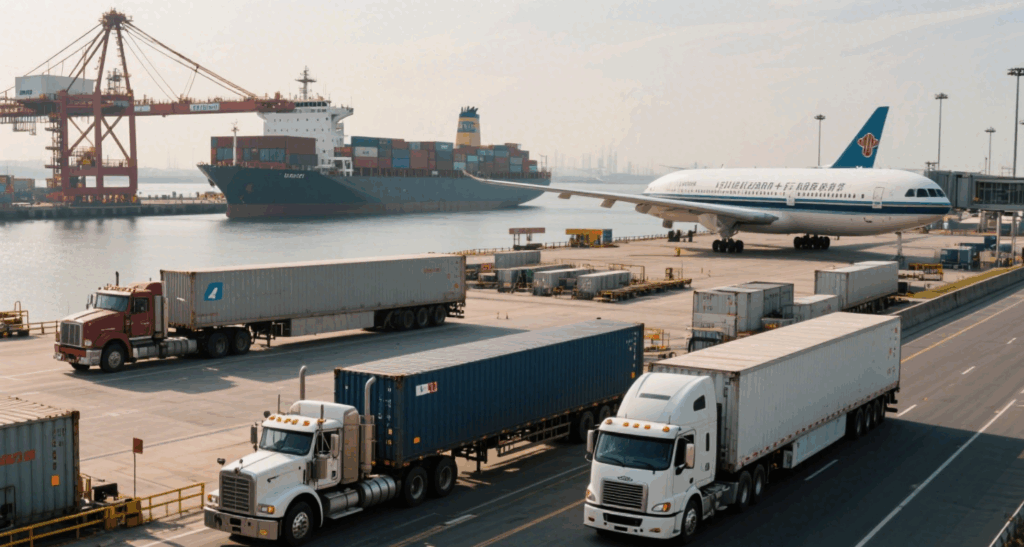- By Della tj
- August 29, 2025
- Sea Freight, Shipping
Table of Contents
A China shipping line plays a central role in international logistics, connecting China’s vast manufacturing industry with buyers around the globe. From electronics and clothing to raw materials and heavy machinery, millions of tons of goods are transported through shipping lines every year.
For importers, the challenge lies in choosing the right service, understanding the costs, and avoiding common shipping problems. This article provides a comprehensive guide to China shipping lines, explaining what they are, how they operate, their advantages, real case studies, and solutions to shipping challenges.
What is a China Shipping Line?
A China shipping line is a company or service that operates container vessels and provides transportation of goods between Chinese ports and international destinations. Major shipping lines such as COSCO Shipping, China Shipping Container Lines (CSCL), and China Merchants have built one of the world’s most powerful maritime networks.
These lines offer Full Container Load (FCL) and Less-than-Container Load (LCL) services, as well as specialized solutions like reefer containers for perishable goods.
What Does It Do?
A shipping line’s main responsibility is to move goods from origin to destination. In addition, they:
- Provide scheduled routes connecting China to global ports.
- Offer different vessel sizes to accommodate various cargo volumes.
- Ensure cargo safety through containerized shipping.
- Support international trade with logistics partnerships.
In short, a China shipping line ensures global supply chains remain connected.
What Does It Do in Different Modes of Transportation?
| Mode of Transport | Average Cost | Transit Time | Best Use Case |
|---|---|---|---|
| Sea Freight (FCL) | $2,100–$3,500 per 20GP | 25–40 days | Bulk goods, machinery |
| Sea Freight (LCL) | $35–$50 per CBM | 30–42 days | Small to mid-size shipments |
| Air Freight (via airline cargo partners) | $6–$9 per kg | 5–10 days | Urgent electronics, perishables |
| Courier Service (partnered with DHL/UPS) | $7–$12 per kg | 3–6 days | Small e-commerce parcels |
- Sea freight is the backbone of shipping lines.
- Air freight is often arranged through cargo partnerships with airlines.
- Courier shipments are integrated for small parcels.

Relevant Terms and Conditions
- Bill of Lading (B/L): Shipping line issues this as proof of carriage.
- Incoterms (FOB, CIF, DDP): Define buyer and seller responsibilities.
- Freight Surcharge: May include fuel adjustment, congestion fee, or peak season surcharges.
- Demurrage Fees: Charged if containers stay too long at port.
- Customs Clearance: Managed either by freight forwarders or through the line’s agents.
Differences in Performance Across Countries
- USA: Transit times are longer (30–40 days) but port efficiency is high.
- Europe: China shipping line connects via direct routes to Rotterdam, Hamburg, and Antwerp in ~28–35 days.
- Africa: Costs are higher due to limited return cargo, and congestion in Lagos/Abidjan is common.
- Middle East: Shorter routes to Jebel Ali (Dubai) and Dammam, often under 20 days.
How to Avoid Common Problems
Common Issues & Solutions
- Schedule Changes: Always have buffer time and confirm with the shipping line.
- Hidden Costs: Clarify documentation, handling, and port surcharges in advance.
- Port Congestion: Choose alternative ports (e.g., Damietta instead of Alexandria).
- Damaged Goods: Use insurance and proper packaging.
Real-World Case Studies
Case 1: Sea Freight (China → Germany)
📍Cargo: 1×40HQ container electronics
📍Origin: Shanghai, China
📍Destination: Hamburg, Germany
📍Cost Breakdown:
- Ocean freight: $3,250
- Local charges: $420
- Customs & VAT: $2,600
- Inland trucking: $480
- Total: $6,750
📍Transit Time: 33 days
📍Result: Electronics importer met launch deadline for new retail store.
Case 2: Sea Freight (China → Egypt)
📍Cargo: 20GP container textiles
📍Origin: Ningbo, China
📍Destination: Alexandria, Egypt
📍Cost Breakdown:
- Ocean freight: $2,450
- Local charges: $380
- Duties & VAT: $1,900
- Inland delivery to Cairo: $350
- Total: $5,080
📍Transit Time: 29 days
📍Result: Egyptian clothing company avoided stock shortages during peak season.
Conclusion
A China shipping line is the backbone of international trade, connecting suppliers and buyers worldwide. Importers can reduce risks and costs by choosing reliable shipping lines, planning ahead, and working with experienced logistics partners.
For tailored shipping solutions, visit Top China Freight and consult with experts who understand global trade.
Request a Quote
Need a tailored solution for your shipping from China?
Let TJ China Freight Forwarder assist you with reliable, cost-effective service.
FAQ:
Q1.Which is the largest China shipping line?
COSCO Shipping is the biggest, ranking among the top 5 globally.
Q2.Do shipping lines provide insurance?
Most do not, but forwarders and insurers offer cargo coverage.
Q3.What is the difference between a shipping line and a forwarder?
A shipping line owns vessels, while a forwarder arranges transport through them.
Q4.How do I book space with a China shipping line?
Importers usually go through freight forwarders who have contracts with the lines.
Q5.What factors affect China shipping line costs?
Fuel prices, port fees, peak season demand, and cargo type.

